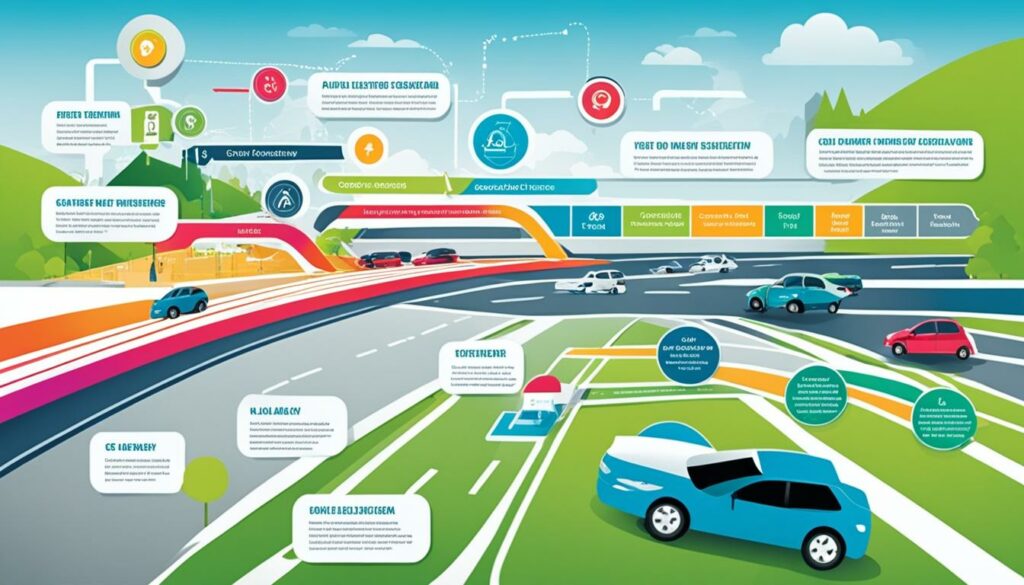Proven Action to Cut Teen Speeding Habits
Speeding is a significant problem among teen drivers in the United States. Over the past five years, approximately one-third of all people killed in motor vehicle crashes were victims of speeding. Teen drivers, in particular, are more prone to speed due to their lack of experience and susceptibility to risky behaviors. It is crucial to address this issue and take action to reduce speeding among teens, promoting safer driving habits and preventing tragic accidents.
Key Takeaways:
- Teen speeding is a major concern, contributing to a significant number of fatal crashes.
- Inexperience and peer influence play key roles in teen speeding behavior.
- Graduated Driver Licensing (GDL) systems have proven effective in reducing teen speeding.
- Parental involvement and education programs are crucial in addressing teen speeding habits.
- Utilizing technology, such as online training resources and cellphone apps, can help mitigate teen speeding.
The Disproportionate Risk for Teen Drivers

When it comes to speeding, the risks are even higher for teen drivers. With their lack of experience and propensity for risky behaviors, teenagers are more likely to be involved in fatal crashes that are linked to speeding. In fact, a staggering 43% of all teen driver and passenger fatalities during a five-year period were speed-related. This alarming statistic emphasizes the urgent need to address the issue of teen speeding and implement effective actions to reduce this dangerous behavior.
“Speeding is a major contributing factor in crashes involving teen drivers. By understanding the specific risk factors and behaviors associated with teen speeding, we can develop targeted strategies to tackle this issue head-on.”
While both male and female teen drivers face risks associated with speeding, studies indicate that male drivers are more likely to be involved in crashes related to excessive speed. This is often attributed to a combination of factors including higher testosterone levels and a higher likelihood of engaging in sensation-seeking behaviors. By understanding these risk factors, we can tailor interventions and education programs to address the specific needs of male teen drivers and help them develop safer driving habits.
It is crucial to recognize the disproportionate risk that teen drivers face when it comes to speeding. By taking proactive measures and implementing effective actions, we can make significant strides in reducing teen speeding and promoting safer roadways for all. Let’s delve deeper into the risk factors and behaviors associated with teen speeding to gain valuable insights for effective interventions.
The Disproportionate Risk of Speeding for Teen Drivers
| Risk Factors | Statistics |
|---|---|
| Male Teenagers | More likely to be involved in crashes related to speeding |
| Less Experience | Prone to poor judgment, inadequate hazard perception, and difficulty maintaining vehicle control at high speeds |
| Sensation-Seeking Behaviors | Higher likelihood of engaging in risky behaviors, such as excessive speed, to experience excitement or thrill |
Inexperience and Peer Influence

When it comes to teen speeding, two factors play a significant role: inexperience and peer influence. Teen drivers often lack the necessary experience to recognize and react appropriately to dangerous situations on the road. This lack of experience makes speeding even riskier for them, as they may not have the skills to handle unexpected events that occur at high speeds.
Furthermore, peer influence can contribute to teen speeding habits. Teenagers are highly susceptible to the behavioral norms and expectations set by their peers. If they observe their friends engaging in speeding behavior, they may feel pressured to do the same, considering it as a normal part of driving.
“I saw my friends driving fast, so I thought it was cool. I didn’t realize the risks involved until I witnessed a close call myself.”
Young drivers may also observe speeding behavior among adults. If they see adults in their lives engaging in speeding, it can normalize this risky behavior and make them less cautious about the consequences of driving above the speed limit.
To mitigate the influence of inexperience and peer pressure on teen speeding, strategies need to be implemented. Effective methods to decrease speeding in teenagers can include educating them about the risks, providing alternative role models, and promoting safe driving habits through positive reinforcement.
Educational Programs
Educational programs can play a vital role in addressing the inexperience of teen drivers. By providing comprehensive driver education courses, young drivers can learn about the potential consequences of speeding and gain the necessary skills to make safer decisions on the road.
“Attending a defensive driving class gave me a better understanding of the dangers of speeding. I learned how to assess different road situations and react appropriately, which helped me become a more responsible driver.”
Through these programs, teenagers can develop a better understanding of the importance of adhering to speed limits and the potential risks associated with driving at high speeds.
Positive Role Models
Including positive role models in a teenager’s life can also mitigate the influence of peer pressure. By introducing responsible adult drivers, such as parents or mentors, who prioritize safe driving practices, young drivers can observe and emulate these positive behaviors.
“My dad always drives within the speed limit and emphasizes the importance of being patient on the road. His behavior has influenced my own driving habits, and I strive to imitate his responsible approach.”
Having positive role models can help reshape a teenager’s perception of speeding as a norm and encourage them to prioritize safety over conformity.
| Methods to Decrease Speeding in Teenagers | Strategies for Mitigating Speeding in Teens |
|---|---|
| Educational programs | Positive role models |
| Teaching the consequences of speeding | Creating a culture of safe driving |
| Developing decision-making skills | Encouraging open conversations about driving habits |
| Practicing defensive driving techniques | Setting clear expectations and consequences |
By addressing the factors of inexperience and peer influence, we can implement effective strategies to decrease speeding in teenagers and promote safer driving habits. Through education, positive role models, and a culture of safe driving, we can empower young drivers to make responsible choices on the road.
Effectiveness of Graduated Driver Licensing

When it comes to addressing teen speeding and promoting safe driving practices, Graduated Driver Licensing (GDL) systems have proven to be highly effective. GDL systems are implemented by states and involve gradually introducing driving privileges and restrictions to young drivers.
By implementing GDL systems, states can help reduce teen speeding by implementing measures such as limiting nighttime driving and the number of passengers allowed in the vehicle. These restrictions are crucial in mitigating the risks associated with inexperienced teen drivers.
GDL systems have shown significant success in reducing teen speeding and improving overall road safety. Research has indicated that states with stricter GDL systems experience lower rates of speeding-related accidents among teens.
“GDL systems are designed to ensure that young drivers gain experience and maturity behind the wheel before obtaining full driving privileges. This approach helps address the heightened risk of speeding among teen drivers.”
By imposing restrictions and gradually easing them as the teen gains experience, GDL systems provide an effective framework for addressing teen speeding. These systems also incorporate valuable educational components, requiring young drivers to complete driver education courses and accumulate a certain number of supervised driving hours.
Overall, GDL systems are a proactive and comprehensive approach to reducing teen speeding and promoting safe driving habits. By implementing these systems, states can play a pivotal role in ensuring the safety of young drivers and other road users.
| Benefits of GDL Systems for Reducing Teen Speeding | Statistics |
|---|---|
| Gradual introduction of driving privileges and restrictions | Studies show that states with GDL systems experience up to a 30% reduction in speeding-related accidents among teens. |
| Education requirements for young drivers | States with GDL systems have seen a significant decrease in speeding-related fatalities among young drivers. |
| Supervised driving hours | Teens who complete the required number of supervised driving hours under GDL systems demonstrate safer driving behaviors. |
The Power of Parental Involvement

When it comes to reducing teen speeding, one of the most powerful techniques is parental involvement. Parents play a critical role in shaping their teenager’s driving behavior and instilling safe practices behind the wheel. By establishing parent-teen driving agreements, parents can set clear rules and expectations, providing guidance and reinforcement for responsible driving habits.
Parent-teen driving agreements serve as a contractual agreement between parents and their teenage drivers, outlining the rules and consequences for breaking them. These agreements are a proven approach to address teen speeding, as they provide structure and accountability while promoting open communication between parents and teens.
Creating an effective parent-teen driving agreement involves open and honest discussions about the risks of speeding and the importance of following traffic laws. Parents should emphasize the need for responsible driving and the potential consequences of reckless behavior. By involving teens in the agreement-making process, parents can ensure that they understand and take ownership of the commitments they are making.
Tips for Creating Effective Parent-Teen Driving Agreements
- Set clear expectations: Clearly define the rules and consequences related to speeding, including specific speed limits and restrictions.
- Be realistic: Set rules that are realistic and achievable, taking into account the teen’s driving experience and skill level.
- Lead by example: Parents should practice what they preach by following the same rules they expect their teen to adhere to.
- Encourage open communication: Create an environment where teens feel comfortable discussing their driving experiences and concerns.
- Regularly review and update: As teens gain more experience and demonstrate responsible driving, revisit and update the agreement to reflect their progress and growing responsibilities on the road.
Parent-teen driving agreements are an essential tool in reducing teen speeding and promoting safer driving habits. By actively involving parents in their teenager’s driving education and establishing clear guidelines, we can work together to create a safer driving environment for young motorists.
Remember, parental involvement is just one piece of the puzzle in addressing teen speeding. In the next section, we will explore the importance of educating both teens and parents about the dangers of speeding and the role of peer-to-peer and parent-education programs in promoting safer driving habits.
Educating Teens and Parents

Peer-to-peer and parent-education programs are essential components of effective interventions to address teen speeding. These programs provide valuable information and resources that can help educate both teens and their parents about the dangers of speeding. By raising awareness and fostering a deeper understanding of the consequences, these initiatives aim to promote safer driving habits among young drivers.
The Importance of Peer-to-Peer Programs
Peer-to-peer programs play a crucial role in reaching and influencing teenagers. By harnessing the power of relatability and shared experiences, these programs create a safe space for teens to learn from their peers and engage in meaningful discussions about safe driving. Through interactive educational sessions, workshops, and peer-led campaigns, these initiatives aim to shift attitudes and behaviors related to speeding.
“Teens are more likely to listen to their peers and be influenced by them. Peer-to-peer programs provide an effective platform for young drivers to learn from each other, share personal stories, and understand the real-life consequences of speeding.”
Empowering Parents through Education
Parent-education programs are equally vital in reducing teen speeding. These initiatives equip parents with the knowledge, skills, and resources needed to effectively communicate with their teen drivers about the risks associated with speeding. By providing parents with evidence-based strategies, such as setting clear expectations, monitoring their teen’s driving behavior, and leading by example, these programs empower parents to take an active role in promoting safe driving habits.
The Potential Impact
When implemented effectively, peer-to-peer and parent-education programs have the potential to significantly reduce teen speeding and improve overall road safety. By combining the influence of peers and the guidance of parents, these interventions create a comprehensive approach that addresses both the social and familial aspects of teen driving behavior. Through education and awareness, young drivers gain a better understanding of the risks they face and are more likely to make responsible choices behind the wheel.
| Benefits of Peer-to-Peer and Parent-Education Programs | Impact |
|---|---|
| 1. Increased awareness of the dangers of speeding | 1. Shift in attitudes towards safe driving |
| 2. Peer influence to promote responsible behavior | 2. Reduction in risky driving habits |
| 3. Improved parental involvement and communication | 3. Strengthened parent-teen relationships |
| 4. Enhanced understanding of the consequences of speeding | 4. Increased compliance with speed limits |
Utilizing Technology for Safer Driving

Technology plays a crucial role in addressing the issue of teen speeding and promoting safer driving habits. By harnessing the power of online training resources and in-vehicle safety technology, we can effectively decrease speeding in teenagers.
Online Training Resources
Online training courses provide a convenient and accessible way for teens to learn about safe driving practices. These courses offer educational materials, interactive exercises, and quizzes that help teenagers develop the necessary skills and knowledge to become responsible drivers. Through engaging and informative online training, teens can understand the risks associated with speeding and the importance of adhering to speed limits.
“Online training courses offer the flexibility and convenience for teens to learn at their own pace while providing valuable information about the consequences of speeding.”
By taking advantage of online training resources, teens can learn the essential techniques for safe driving, such as maintaining a safe following distance, using turn signals, and obeying traffic laws. These courses also emphasize the dangers of distracted driving and highlight the importance of focusing on the road to prevent speed-related accidents.
In-Vehicle Safety Technology
In-vehicle safety technology has evolved significantly over the years, offering innovative solutions to mitigate teen speeding. Speed monitoring systems, for example, can provide real-time feedback and reinforcement to young drivers. These systems use GPS technology to track the vehicle’s speed and alert the driver when they exceed the speed limit.
“In-vehicle speed monitoring systems empower teens to take control of their own driving behavior by providing immediate feedback that encourages them to abide by speed limits.”
Additionally, some in-vehicle safety technologies, such as lane departure warning systems and forward collision warning systems, can help teens avoid risky driving situations that may lead to excessive speeding. These advanced safety features provide visual and auditory alerts to remind drivers of potential hazards, assisting them in maintaining a safe speed and avoiding accidents.
By utilizing technology in the form of online training resources and in-vehicle safety technology, we can effectively decrease teen speeding and foster a culture of responsible driving among young motorists.
Harnessing the Power of Technology

In today’s digital age, technology offers a powerful solution for reducing teen speeding and promoting safer driving habits. One such innovative tool available to parents is the use of cellphone apps specifically designed to monitor and track teen speeding. These apps not only provide valuable information but also empower parents to take proactive steps in addressing any potential speeding issues.
By leveraging cellphone apps, parents can effortlessly track the speed of their teen driver in real-time, ensuring that they adhere to the posted speed limits. These apps offer a range of features that enable parents to monitor their teen’s driving behavior effectively. Parents receive alerts and notifications if their teen exceeds the speed limit, providing an opportunity to initiate a constructive conversation about the importance of safe driving.
Cellphone apps also allow parents to review historical data, providing valuable insights into their teen’s driving patterns. By analyzing these trends, parents can better understand their teen’s driving habits and identify areas for improvement. This information serves as a foundation for open and honest discussions about the potential consequences of speeding and the need for responsible driving practices.
Furthermore, cellphone apps provide an additional layer of accountability for teen drivers. Knowing that their driving is being monitored may encourage teens to adopt safer behaviors on the road. This increased awareness can lead to a reduction in speeding incidents and a greater commitment to responsible driving habits.
Overall, cellphone apps offer a convenient and effective means of reducing teen speeding and promoting safer driving practices. By harnessing the power of technology, parents can actively engage with their teen drivers and work together to mitigate the risks associated with speeding.
Collaborating for Safer Roads
State Highway Safety Offices play a crucial role in addressing teen speeding and promoting safer driving practices. These offices can support education and awareness campaigns, collaborate with schools and community organizations, and advocate for legislation to enhance teen driving safety. By working together, we can implement effective interventions to reduce speeding in teens and create safer roads for everyone.
Education and Awareness Campaigns
State Highway Safety Offices can initiate and support education and awareness campaigns targeting both teens and parents. These campaigns can provide valuable information about the dangers of speeding and promote responsible driving behaviors. Through engaging and informative materials, such as brochures, posters, and online resources, these campaigns can effectively reach their target audience and raise awareness about the consequences of teen speeding.
Collaboration with Schools and Community Organizations
Collaborating with schools and community organizations is essential in addressing teen speeding. State Highway Safety Offices can partner with schools to integrate safe driving education into the curriculum, conduct workshops and presentations, and organize events that promote responsible driving habits. Furthermore, working with community organizations, such as youth clubs and sports teams, can provide additional opportunities to reach out to teens and engage them in discussions about the importance of safe driving.
Advocacy for Legislation
State Highway Safety Offices can play a vital role in advocating for legislation that enhances teen driving safety. By working closely with lawmakers and policymakers, these offices can contribute to the development and implementation of effective laws and regulations. Some potential legislative measures include stricter penalties for speeding offenses, restrictions on novice drivers, and increased enforcement efforts. By advocating for such legislation, State Highway Safety Offices can help create an environment that discourages teen speeding and encourages responsible driving.
By actively collaborating and leveraging their resources, State Highway Safety Offices can make a significant impact in reducing teen speeding and enhancing overall road safety. Their involvement is crucial in implementing successful interventions and ensuring that teens adopt safer driving habits.
The Power of Role Modeling
Parents have a significant influence on their teen’s driving habits. By being a good role model and practicing safe driving habits themselves, parents can set a positive example for their teen drivers. Studies have shown that teens are more likely to engage in speeding behavior if they witness their parents doing the same.
When parents demonstrate responsible driving behaviors such as obeying speed limits, using turn signals, and maintaining a calm and focused demeanor behind the wheel, they send a powerful message to their teen drivers. By providing a consistent model of safe driving, parents can help teens develop the skills and attitudes needed to make sound decisions on the road.
Impact of Parental Influence on Teen Speeding
Research has shown that parental influence plays a crucial role in shaping teen driving habits. Teens who perceive their parents as supportive and involved in their driving experience are more likely to follow safe driving practices, including obeying speed limits. Conversely, teens who feel that their parents are lenient or indifferent towards speeding may engage in risky behaviors behind the wheel.
“Parents have a unique opportunity to make a lasting impact on their teen’s driving behavior. By demonstrating safe driving habits and open communication, parents can help prevent their teens from engaging in speeding and reduce the risk of accidents on the road.”
– Dr. Jennifer Adams, Traffic Safety Expert
Tips for Parents to Promote Safe Driving Behaviors
Here are some effective strategies for parents to promote safe driving habits and reduce teen speeding:
- Be a role model: Practice safe driving habits yourself, including obeying speed limits and avoiding aggressive driving behaviors.
- Communicate openly: Have regular conversations with your teen about the dangers of speeding and the importance of responsible driving.
- Set clear expectations: Establish clear rules and consequences for speeding, and consistently enforce them.
- Ride along: Take an active role in your teen’s driving experience by periodically riding along as a passenger and providing feedback and guidance.
- Encourage defensive driving: Teach your teen defensive driving techniques, such as scanning the road ahead, maintaining a safe following distance, and anticipating potential hazards.
By implementing these tips, parents can make a positive impact on their teen’s driving behavior and create a safer environment on the roads.
The Harsh Realities of Speeding
Teen speeding can have severe consequences, including fatal crashes and the loss of young lives. It is crucial to address this issue and implement effective measures to decrease speeding in teenagers and promote safer driving habits.
“Speeding is a contributing factor in approximately 30% of all fatal crashes in the United States.”
Statistics reveal the grim reality of the impact of teen speeding on road safety. According to the National Highway Traffic Safety Administration (NHTSA), speeding is a contributing factor in approximately 30% of all fatal crashes in the United States(NHTSA, 2021).
The consequences of teen speeding go beyond the loss of young lives. Speeding can result in severe injuries, property damage, and emotional trauma for those involved in these accidents. It can also have long-lasting effects on the families and communities affected by these tragedies(NHTSA, 2021).
Addressing teen speeding requires a multifaceted approach that combines various approaches and strategies. By implementing proven methods to decrease speeding in teenagers, we can make significant progress in reducing the risks associated with teen speeding and promoting safer roads for everyone.
The Importance of Education and Awareness
One approach to address teen speeding is through comprehensive education and awareness programs. Educating teenagers about the dangers and consequences of speeding can help them make informed decisions on the road. It is essential to emphasize the potential risks, such as loss of vehicle control and decreased reaction time, to discourage speeding behaviors(NHTSA, 2021).
Additionally, raising awareness among parents and caregivers about the importance of addressing teen speeding is crucial. Parents play a vital role in instilling safe driving behaviors in their teenagers. By providing them with the necessary information and resources, parents can actively contribute to reducing teen speeding(NHTSA, 2021).
Enforcement and Technology
Strict enforcement of speed limits is another effective approach to discourage teen speeding. Law enforcement agencies can actively patrol known speeding areas and implement speed detection devices to deter violators(NHTSA, 2021).
Moreover, technology can play a significant role in addressing teen speeding. In-vehicle monitoring systems and smartphone applications can provide real-time feedback and help parents keep track of their teenager’s driving habits. These tools can alert parents when their teenagers exceed speed limits, enabling them to address any speeding issues promptly(NHTSA, 2021).
Collaboration and Support
Addressing teen speeding requires the collaboration of various stakeholders, including parents, educators, law enforcement agencies, and community organizations. By working together, we can develop comprehensive strategies and initiatives to decrease speeding in teenagers and create safer roads(NHTSA, 2021).
Table: Key Statistics on Teen Speeding and Consequences
| Statistic | Data |
|---|---|
| Percentage of fatal crashes involving speeding(NHTSA, 2021) | 30% |
| Percentage of teen driver fatalities related to speeding(NHTSA, 2021) | 43% |
| Impact of speeding on crash severity(NHTSA, 2021) | Increases crash severity and risk of severe injuries |
The statistics and data on the consequences of teen speeding underscore the urgency and importance of addressing this issue. By implementing effective approaches and methods to decrease speeding in teenagers, we can work towards safer roads and protect the lives of young drivers and those around them.
Taking Action for Safer Roads
Reducing speeding among teenagers requires a collaborative effort from various stakeholders – parents, educators, policymakers, and technology. By implementing proven strategies and initiatives, we can effectively address the issue of teen speeding and promote safer driving habits among young motorists.
One of the key approaches is the implementation of parent-teen driving agreements. These agreements establish clear rules and expectations for young drivers, helping them understand the importance of safe driving practices and the consequences of speeding. By incorporating parental involvement and guidance, we can instill responsible driving behavior in teens.
Furthermore, state Graduated Driver Licensing (GDL) systems have proven to be successful in reducing teen speeding. GDL systems gradually introduce driving privileges and restrictions, such as limiting nighttime driving and the number of passengers, allowing teens to gain experience and develop responsible driving habits over time.
Educational programs also play a crucial role in addressing teen speeding. By educating both teens and parents about the dangers of speeding, we can increase awareness and knowledge about the consequences of this risky behavior. Peer-to-peer and parent-education programs provide valuable resources and information to promote safer driving habits among young drivers.
By combining these strategies with the power of technology, such as online training courses and in-vehicle safety technology, we can provide additional support for reducing teen speeding. Online training courses offer interactive exercises and educational materials to help teens develop safe driving habits, while in-vehicle safety technology, like speed monitoring systems, provides real-time feedback and reinforcement.
Together, through the implementation of these proven strategies and initiatives, we can create safer roads for everyone. By working collaboratively and addressing teen speeding at multiple levels, we can make significant progress in reducing speeding among teenagers and fostering a culture of safe driving habits among young motorists.
FAQ
How can we reduce teen speeding habits?
There are several effective actions that can be taken to reduce teen speeding. Graduated Driver Licensing (GDL) systems, parent-teen driving agreements, peer-to-peer and parent education programs, online training resources, in-vehicle safety technology, cellphone apps, involvement of State Highway Safety Offices, and parental influence all play a crucial role in addressing teen speeding and promoting safer driving habits.
What is Graduated Driver Licensing (GDL)?
Graduated Driver Licensing (GDL) is a system implemented by states that gradually introduces driving privileges and restrictions to young drivers. GDL systems often include limitations on nighttime driving and the number of passengers, which have been shown to effectively reduce teen speeding and promote safe driving practices.
How can parent-teen driving agreements help reduce teen speeding?
Parent-teen driving agreements are an effective way to reduce teen speeding. By setting clear rules and expectations, parents can provide guidance and reinforce safe driving behaviors. These agreements establish boundaries and consequences for breaking the rules, which helps teens understand the importance of obeying speed limits and driving safely.
What role do peer-to-peer and parent education programs play in reducing teen speeding?
Peer-to-peer and parent education programs provide valuable information and resources to educate both teens and parents about the dangers of speeding. These programs help promote safer driving habits among young drivers by raising awareness, providing educational material, and encouraging responsible driving practices.
How can online training resources and in-vehicle safety technology help reduce teen speeding?
Online training resources offer educational material and interactive exercises to help teens develop safe driving habits. These resources provide valuable information on the consequences of speeding and teach defensive driving techniques. In-vehicle safety technology, such as speed monitoring systems, can provide real-time feedback and reinforcement to help teens stay within the speed limit.
How can cellphone apps help reduce teen speeding?
Cellphone apps can be used to monitor teen speeding and provide valuable information to parents. These apps track the speed of a teen driver and can send alerts to parents if the speed limit is exceeded. By using these apps, parents can have a better understanding of their teen’s driving behavior and address any speeding issues promptly.
What is the role of State Highway Safety Offices in addressing teen speeding?
State Highway Safety Offices play a crucial role in addressing teen speeding and promoting safer driving practices. They support education and awareness campaigns, collaborate with schools and community organizations, and advocate for legislation to enhance teen driving safety. By actively participating in these efforts, State Highway Safety Offices contribute to reducing teen speeding and creating safer roads.
How can parents influence their teen’s driving behavior and reduce speeding?
Parents have a significant influence on their teen’s driving habits. By being a good role model themselves and practicing safe driving habits, parents can set a positive example for their teen drivers. Additionally, having open conversations about the importance of obeying speed limits and emphasizing the consequences of speeding can help shape their teen’s driving behavior and reduce the likelihood of speeding.
What are the consequences of teen speeding?
Teen speeding can have severe consequences, including fatal crashes and the loss of young lives. Statistics show that a significant proportion of teen driver and passenger fatalities are speed-related. Speeding increases the risk of losing control of the vehicle, reduces the effectiveness of safety equipment, and increases the likelihood of serious injuries or fatalities in the event of a collision.
How can we take action to reduce teen speeding?
Taking action to reduce teen speeding requires a multi-faceted approach involving parents, educators, policymakers, and technology. By implementing proven strategies such as parent-teen driving agreements, Graduated Driver Licensing systems, educational programs, online training resources, in-vehicle safety technology, and collaborating with State Highway Safety Offices, we can make significant progress in reducing teen speeding and promoting safe driving habits.







